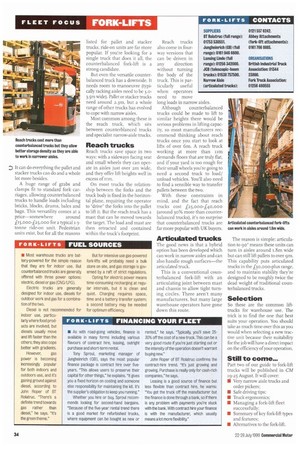It can do everything the pallet and stacker trucks can
Page 36

If you've noticed an error in this article please click here to report it so we can fix it.
do and a whole lot more besides, A huge range of grabs and clamps fit to standard fork carriages, allowing counterbalanced trucks to handle loads including bricks, blocks, drums, bales and bags. This versatility comes at a price—somewhere around D5,000-125,000 for a typical tonne ride-on unit. Pedestrian units exist, but for all the reasons listed for pallet and stacker trucks, ride-on units are far More popular. If you're looking for a single truck that does it all, the counterbalanced fork-lift is a strong candidate.
But even the versatile counterbalanced truck has a downside. It needs room to manoeuvre (typically racking aisles need to be 3.o3.5m wide). Pallet or stacker trucks need around 2.3m, but a whole range of other trucks has evolved to cope with narrow aisles.
Most common among these is the reach truck, which sits between counterblanced trucks and specialist narrow-aisle trucks.
Reach trucks
Reach trucks save space in two ways: with a sideways facing seat and small wheels they can operate in aisles just over am wide, and they offer lift heights well in excess of TIM.
On most trucks the relationship between the forks and the truck body is fixed in the horizontal plane, requiring the operator to "drive" the forks into the pallet to lift it. But the reach truck has a mast that can be moved towards the target. The load and mast are then retracted and contained within the truck's footprint. Reach trucks also come in fourway versions that can be driven in any direction without turning the body of the truck. This is particularly useful when operators need to move long loads in narrow aisles.
Although counterbalanced trucks could be made to lift to similar heights there would be serious problems in lifting capacity, so most manufacturers recommend thinking about reach trucks once you start to look at lifts of over 6m. A reach truck working at more than urn demands floors that are truly flat, and if your yard is too rough for their small wheels you're going to need a second truck to load/ unload vehicles. You'll also need to find a sensible way to transfer pallets between the two.
With these constraints in mind, and the fact that reach trucks cost f25,000-14o,000 (around 30% more than counterbalanced trucks), it's no surprise that counterbalanced trucks are far more popular with UK buyers.








































































































